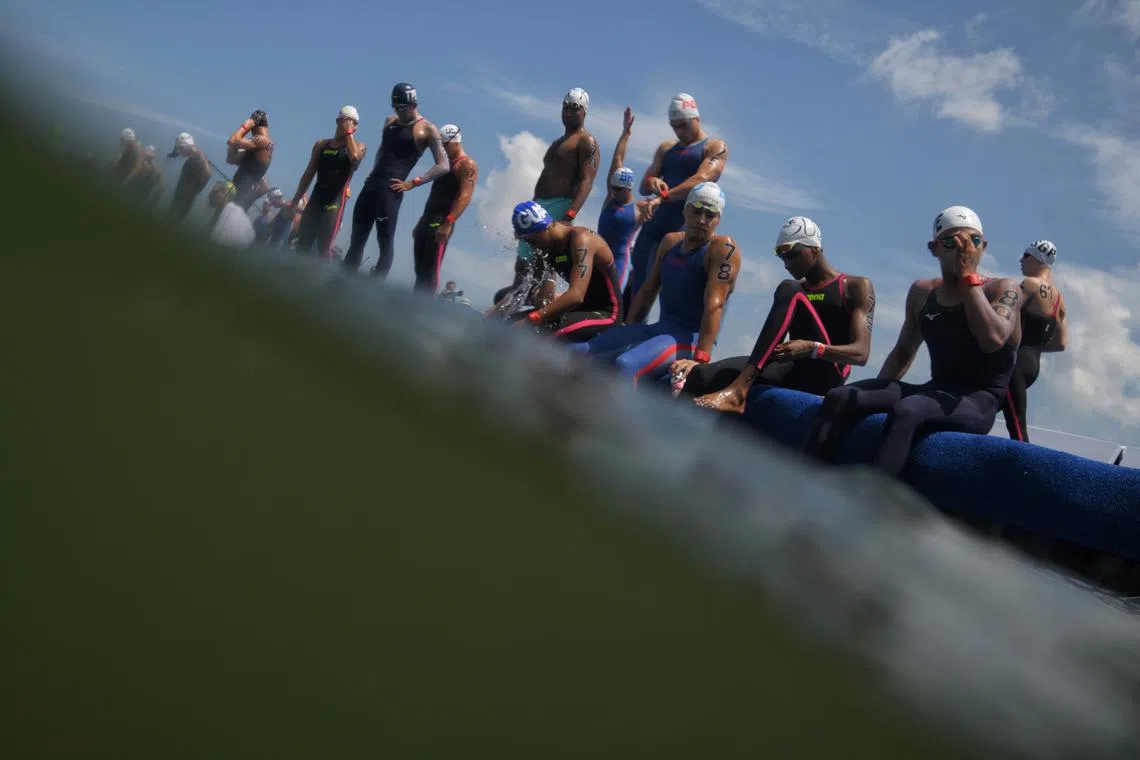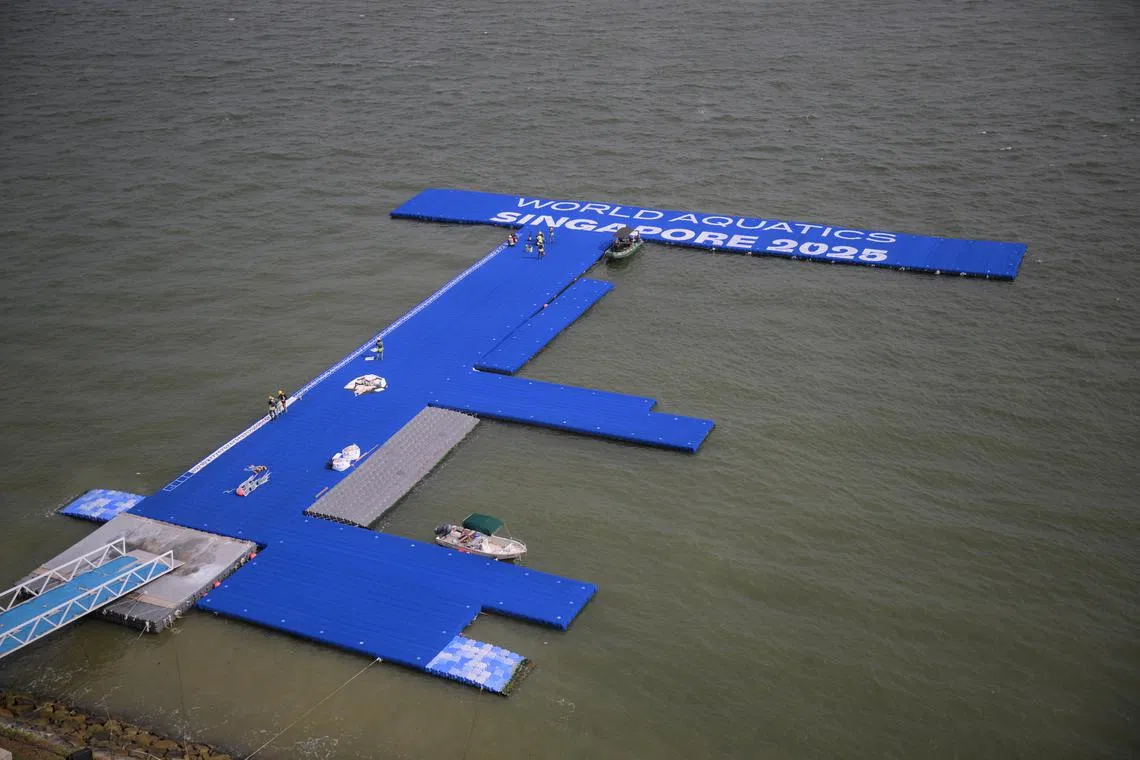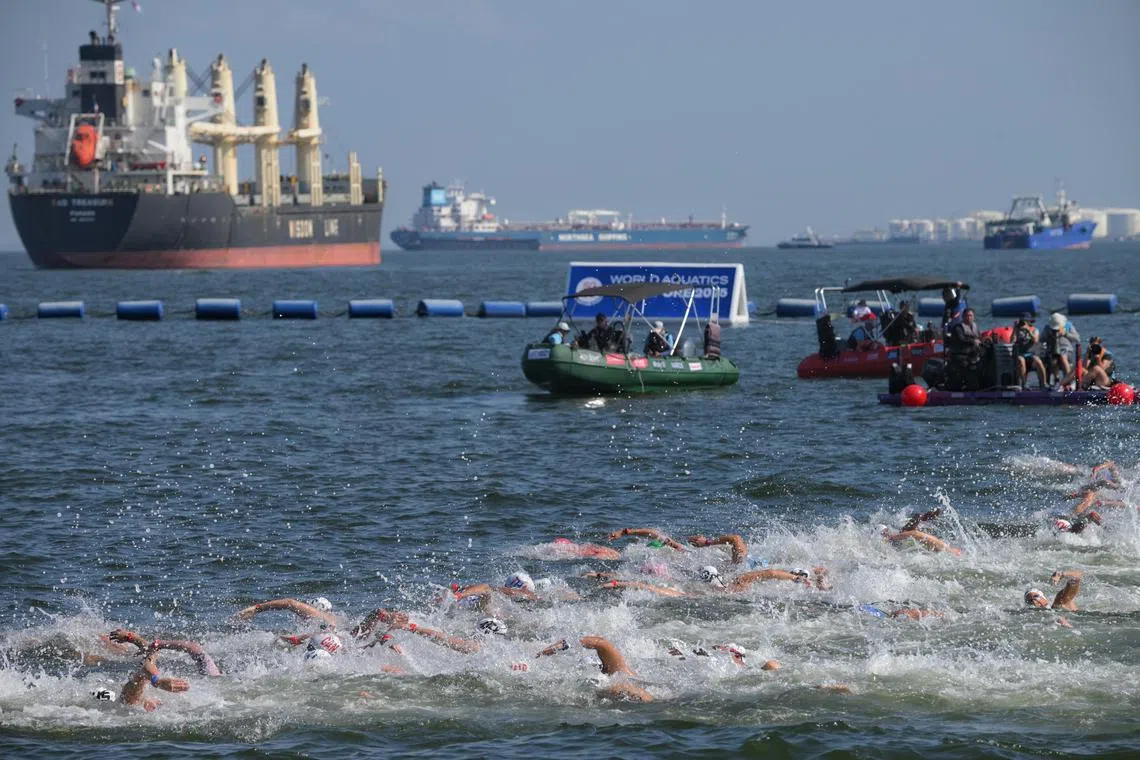NEA monitoring E. coli at Sentosa beaches after elevated bacteria levels delay World Aquatics events
Sign up now: Get ST's newsletters delivered to your inbox

Competitors waiting at the start line ahead of the Men's Open Water 10km final held on Sentosa on July 16.
ST PHOTO: MARK CHEONG
Follow topic:
SINGAPORE - The National Environment Agency (NEA) has started monitoring levels of Escherichia coli (E. coli) at Sentosa’s beaches, after swimming events at the World Aquatics Championships were twice delayed due to elevated levels of the bacteria in the waters.
NEA does not usually assess marine water quality based on E. coli levels. Instead, it follows World Health Organisation (WHO) guidelines to determine the suitability of a recreational beach for primary contact activities, by measuring the levels of another group of bacteria, Enterococcus.
In response to queries from The Straits Times, NEA said that WHO recommends using only Enterococcus for assessing marine water quality. Epidemiological studies have shown a strong correlation between Enterococcus levels in marine waters and public health risks.
WHO has assessed that there is currently insufficient data to develop similar guidelines for E. coli – a suitable faecal indicator for freshwater – for marine waters, NEA added.
“While NEA will continue monitoring our beach water quality based on Enterococcus, we are currently also monitoring E. coli levels at the Sentosa beaches arising from this latest development,” said NEA.
It added that the E. coli levels on July 15 were low and that the agency will continue to monitor the water quality at the Sentosa beaches over the next few days.
NEA said its weekly water monitoring showed that water quality at the beaches has been in the “normal” range in the past few weeks.
The recreational beaches are also graded every six months based on the past 100 samples. NEA said the Sentosa beaches were graded “good” in the latest grading exercise in January, and were suitable for swimming and other primary contact activities.
It is not known what is the cause of the elevated levels of E. coli in the waters, but the bacteria is commonly found in the intestines of people and animals.
While most strains are harmless, some can cause serious illnesses such as diarrhoea, urinary tract infections, pneumonia and sepsis.
Meanwhile, Enterococcus is another group of bacteria – also found naturally in the intestines of animals and humans – which can also cause urinary tract infections and gall bladder infections. It can sometimes be found in soil, water and plants. The bacteria can survive longer in marine environments.
The elevated levels of E. coli in waters at the site off Sentosa have led to delays in open water swimming events at the World Aquatics Championships, which is being held in Singapore for the first time.
According to World Aquatics regulations, E. coli levels in ocean and transitional (tidal) waters must not exceed 250 colony-forming units per 100ml.
ST previously reported that World Aquatics adopts stricter water quality standards compared with guidelines set for recreational swimming, given the prolonged exposure faced by athletes during competition, with 10km races typically lasting around two hours.
The women’s 10km event held in the waters off Palawan Beach was initially scheduled for July 15, but after water samples drawn at the race site off Sentosa two days prior showed “exceeding levels” of E. coli bacteria, the event was moved to July 16 at 10.15am, about three hours after the men’s 10km race.

The next open water swimming events are the men’s and women’s 5km races scheduled for July 18.
PHOTO: ST FILE
The men’s and women’s races were later pushed to 1pm and 4pm, respectively, on July 16 as results from a sample taken on the morning of July 15 showed that the levels were still above “acceptable thresholds” despite improvement.
The next open water swimming events are the men’s and women’s 5km races scheduled for July 18.
World Aquatics had said regular water quality monitoring and testing continues throughout the competition period to ensure athlete safety, with the health and safety of all participants continuing to guide all competition-related decisions.
Associate Professor Yann Boucher, co-director of the climate, environment and health programme at the NUS Saw Swee Hock School of Public Health, said athletes are more at risk as the strenuous exercise can lead to them swallowing more water compared with those doing recreational swimming.
“The length of time spent in the water can also contribute as the risk is proportional to how much water is swallowed,” he added.
Experts said potential sources could vary from animals and humans to wastewater discharge.
Prof Boucher said the bacteria can come from various sources such as birds, humans swimming, wastewater leakage or discharge – which he said is often linked to systems being overwhelmed by heavy downpours.
“E. coli is not native to marine environments and can only survive there for a limited period of time. For levels to remain high, there has to be continuous contamination from human or animal sources as it lives in the gut,” he added.
Professor Paul Tambyah, past president of the International Society for Infectious Diseases, said the bacteria could also come from boats that are not properly disposing of human or animal waste.
He added that seawater is less vulnerable to E. coli and other bacteria due to the higher salt content and direct sunlight, which kills most bacteria.

Experts said potential sources of E. coli bacteria could vary from animals and humans to wastewater discharge.
ST PHOTO: MARK CHEONG
“Most regulatory authorities use E. coli as a marker for how clean the water is, as E. coli grows easily and can be readily detected with commercial kits,” Prof Tambyah said.
“If we begin to see more E. coli in the water near the shore, which does not have such a high salt content, we need to check the waste disposal systems and ensure that there is no contamination of the water by untreated sewage before people start getting sick from salmonella or other infections.”
ST has asked Sentosa Development Corporation and NEA if it is looking into the potential sources of E. coli contamination.
Beachgoers can refer to weekly information on the water quality at the seven popular recreational beaches at go.gov.sg/beach-water-info


